Emotional marketing plays a very important role in your campaigns. Look at these people below. What emotions do they conjure up in you? Does it matter that they’re smiling? Does it matter what they’re wearing?
Absolutely.
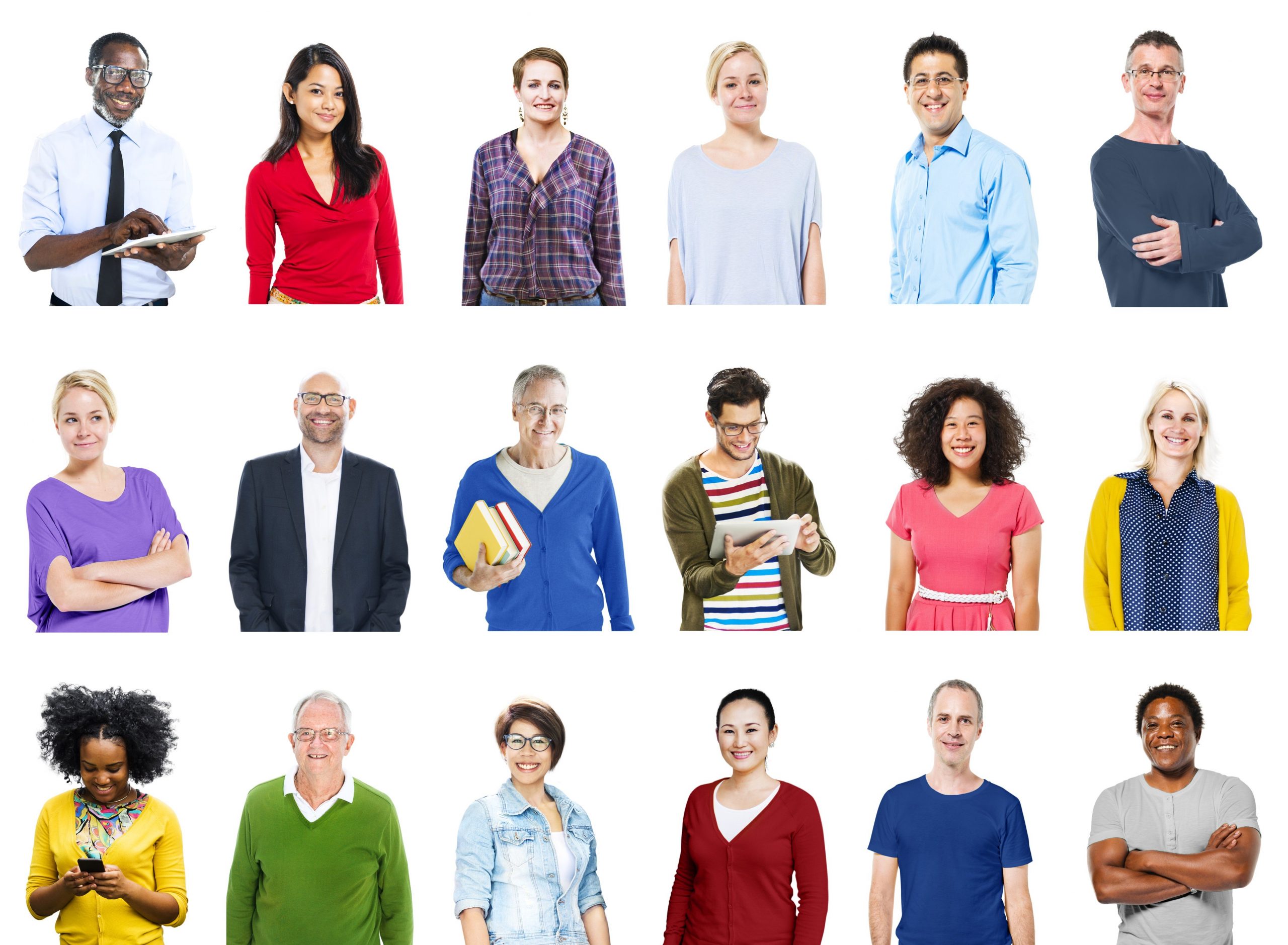
Princeton psychologists learned that first impressions form in less than a second. Sounds crazy but it’s not.
Even though we consider ourselves logical and modern human beings, the majority of our decisions are made by the ancient, instinctive subconscious part of our brains, sometimes referred to as our “reptilian brain.” That doesn’t mean that the quality of our decisions is lowered; some, like Malcolm Gladwell in Blink, argue that quick, gut-level decisions are actually better and save us time and agony.
Let’s explore how emotions play in to modern-day marketing and why…
Emotional branding
According to Entrepreneur magazine, branding is “The marketing practice of creating a name, symbol or design that identifies and differentiates a product from other products.” Emotional branding then, is creating an emotional connection to one company that separates it from the rest, creating brand loyalty over time.
So, what creates this sense of connection?
Apple
Apple may be the perfect example of a company that utilizes emotions to create a connection with consumers and brand loyalty over time. Apple’s branding strategy uses simplicity, a clean design and most importantly, a desire to become part of a lifestyle movement. This well-crafted desire appeals to our most basic emotional need: to be part of something bigger than ourselves. This is one of the reasons why religion and social movements exist, why one is a Democrat or a Republican (or an Independent), or why you might volunteer at a local public school.
Apple recognizes that we are social animals and want to be part of a revolution of sorts — part of the newest cutting-edge technology, part of something important (and Steve Jobs exemplified this brilliantly). Instead of sending out sterile press releases, he created events (that helped spawn recurring announcements like the latest iPhone 7 release) to unveil new Apple products, fostering a sense of mystery and allowing Apple users to feel a part of something big and important. Steve Jobs set the precedent for these events (and their massive impact on consumer culture), and they continue to this day — even after his passing:
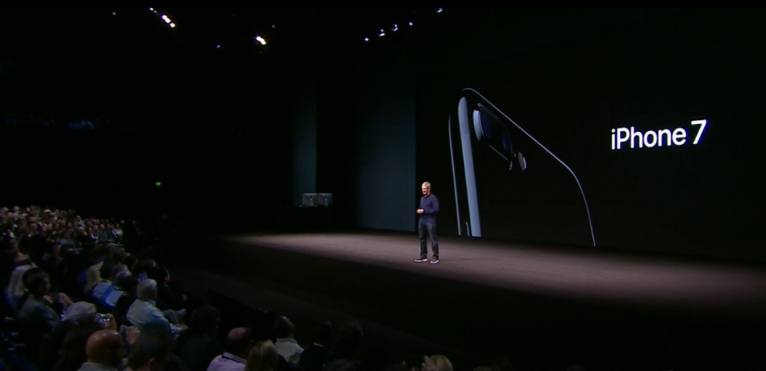
Maslow’s famous hierarchy of needs posits that the highest-level human needs have to do with creativity, respect by others, and belonging to a group. Apple, then, does a brilliant job of appealing to these human needs. They brand themselves as a platform to unleash your creativity, to be part of a technological revolution, and to be respected by others who recognize that you are part of this cultural movement. It’s no surprise then, that graphic designers (creative types) have a tradition of using Mac over PCs.
Emotional advertising
Research on advertising shows that the emotional response to an ad influences consumers’ intention to buy much greater than the ad’s content itself.
We saw this phenomenon with the 2016 Rio Olympics ads. The most-shared ads utilized emotion and universal experiences to foster a sense of connection with viewers.
Gillette’s ad (“Perfect Isn’t Pretty”) exhibited various athlete’s personal and professional struggles that shaped their strong characters. PG&E’s ad (“Thank You, Mom - Strong”) is a series of small stories from different athletes’ lives that show their respective mothers protecting them in a dangerous or traumatic situation, and how they overcame these situations to become the best athletes in the world. These themes — personal struggle and protection from harm by those you love — are universal and touch a deep emotional nerve with viewers.
Storytelling
Narratives and storytelling engage consumers’ subconscious and create an emotional connection with the brand and the story.
Another very popular 2016 Olympics ad that utilized storytelling to engage the viewer is Gatorade’s “The Boy Who Learned To Fly” — an animated short film about Usain Bolt’s life and his connection to his mother. Watching the ad transports the viewer into Bolt’s childhood and subsequent transition to Olympic athlete; we see Bolt running on clouds (flying) with lightning bolts coming from his shoes while he runs. The viewer connects emotionally with Usain, his mother, and in turn, Gatorade:
As the infographic shows below, emotionally-charged storytelling creates a rush of dopamine in the brain, which is linked to memory. The Ted talk “Storytelling, Psychology and Neuroscience” by Amanda D'Annucci, supports this idea about storytelling enhancing the listener’s memory of the story. She discusses how storytelling engages the entire brain including the amygdala, the memory center of the brain. So it makes perfect sense then, that companies leverage storytelling to make an emotional and psychological impact to keep consumers remembering a story, and therefore their brand. Emotional branding at its finest.
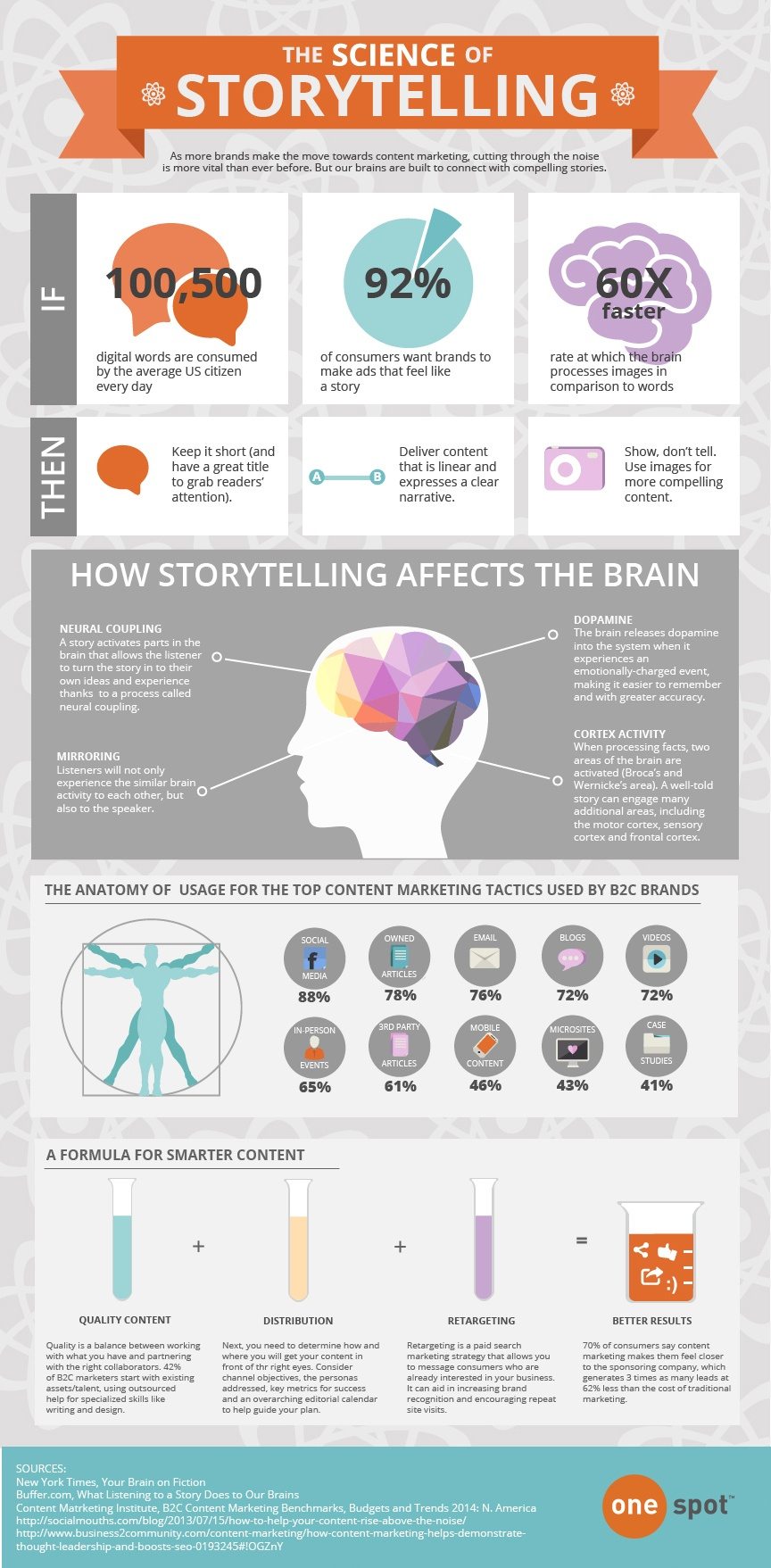
Storytelling can also be leveraged in landing page design and many companies opt for storytelling on their landing pages to increase conversions.
More examples
In 2014, Airbnb created a campaign in New York City that used storytelling to create an emotional connection with potential customers. The Airbnb story below highlights Carol, who uses Airbnb for supplemental income and going back to school. The 30-second YouTube video discusses how she’s been living in Lower Manhattan for 34 years, lost her job, but loves hosting people through Airbnb.
This type of story appeals to the universal desire to help others. By using Airbnb, we can have a place to stay, but also get to know new people and help people like Carol maintain her apartment and lifestyle:
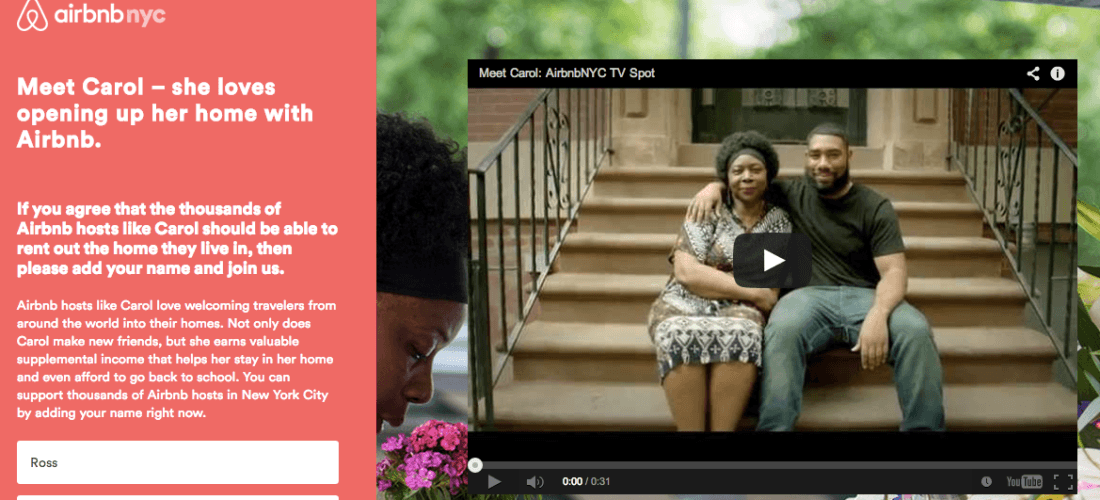
Emotional marketing
Neuro-imagery scans show that when consumers evaluate brands, they use their emotions, based on personal feeling and experiences, rather than information about the brand, such as features and facts. This means that whether you’re marketing a homepage, landing page, or a squeeze page, etc.; connecting emotionally to the viewer is the most important factor.
Since consumers tend to choose brands based on emotions rather than logic, the more emotional intelligence a brand has, the better they will do with conversions and ROI. The Rio Olympics ads discussed previously touched an emotional nerve with consumers so much that consumers shared these videos at an extremely high rate, showing engagement, connection, and peak brand awareness. This incredibly high level of engagement is the Holy Grail in marketing and happens when emotions are involved.
Color me conversions
Colors are scientifically proven to alter a viewer’s emotional, physiological and behavioral states. Gender differences also apply. For example, women are more sensitive to bright colors than men. And different colors evoke different reactions: black and purple are associated with “powerful/strong/masterful,” red is stimulating and blue is associated with “tender/comfortable.”
Now, think of the most famous brands associated with these colors: Facebook blue and Coca-Cola red. That’s no coincidence.
Many marketers take advantage of this color phenomenon by knowing their target audience while playing to the various emotions they want to invoke.
Take a look at a section of Splitit’s homepage below. The colors are a mix of black and purple, both associated with luxury and sophistication. The white space creates contrast, a well-known landing page design technique proven to assist with conversions. The CTA button is a contrasting teal color, drawing maximum attention. In conjunction with this, a testimonial video utilizes the next emotional marketing tactic, social proof:
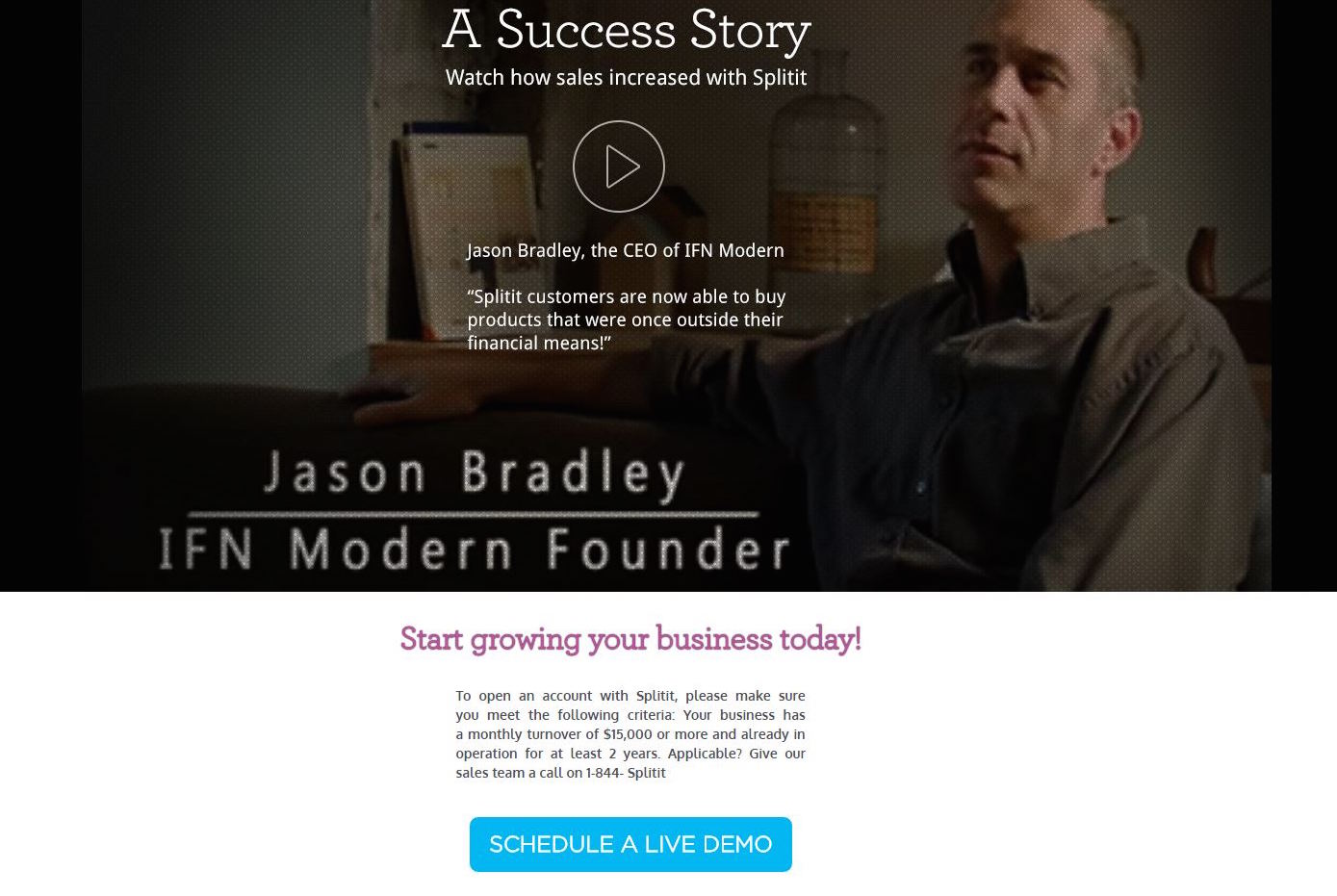
Modern-day social proof
Socially-minded services such as Yelp and Airbnb are popular because they utilize simple yet powerful word-of-mouth.
Companies that highlight word-of-mouth recommendations from clients as part of their emoti0nal marketing strategy get customers to trust them. In turn, our gut-level emotional response says, “If others trust them, I should, too.” Social proof can take many forms: testimonials, customer reviews, company logos, or real customer stories.
Social proof theory gives a person (or company) credibility because of others’ validation. This creates a sense of trust and legitimacy in the person or the company. Many companies utilize this strategy in ads, landing pages, and homepages because of the clear benefits they provide. Research shows that 70% of consumers read product reviews before purchasing, and these reviews are 12 times more trusted than the company’s own product description.
Examples
Below you can see the testimonial section on a landing page from a partnership between SumoMe and Jeff Bullas, that displays specific recommendations from clients (along with their real photos) and a list of other big-name partners. SumoMe is a platform that grows website traffic, and Jeff Bullas has a popular marketing blog and offers marketers tools to help businesses grow. As marketers, both brands understand the power of social proof to help companies succeed:
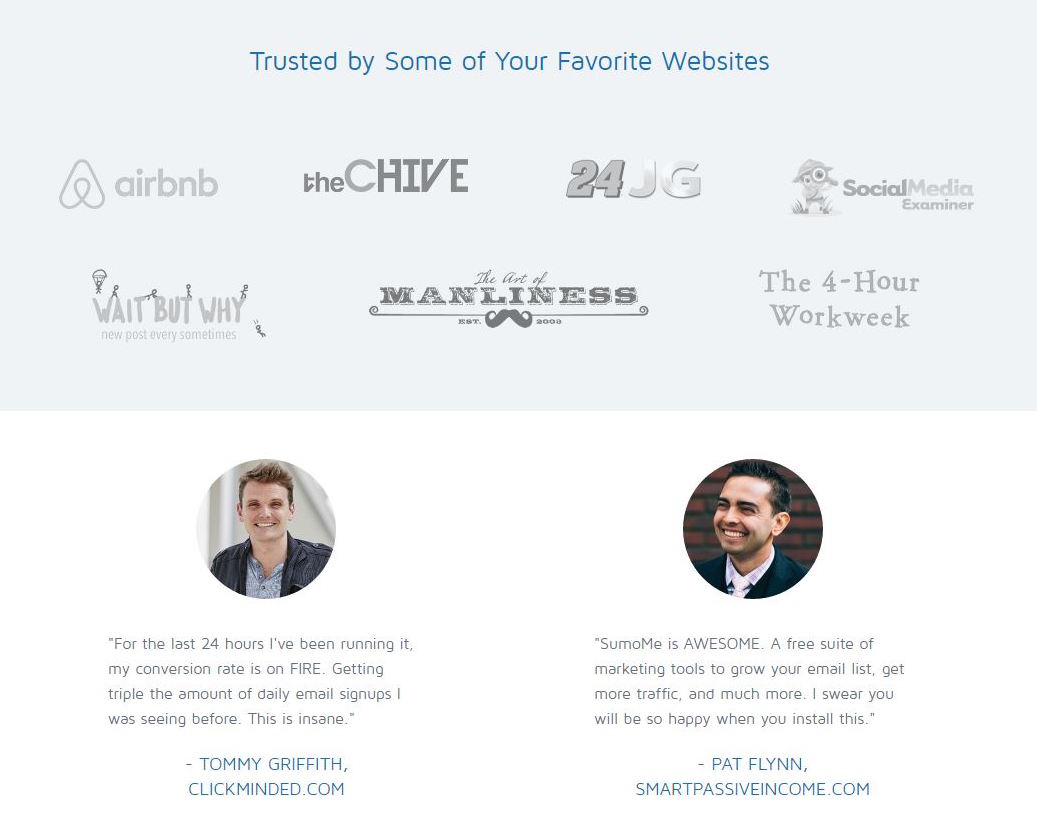
Another company that uses social proof to emotionally connect with potential customers is Appnext, an app monetization platform that primarily uses in-app video and native advertising for app discovery. The page below uses social proof to highlight the vast number of partners using the platform, which communicates to the consumer that their product is legitimate and trustworthy:
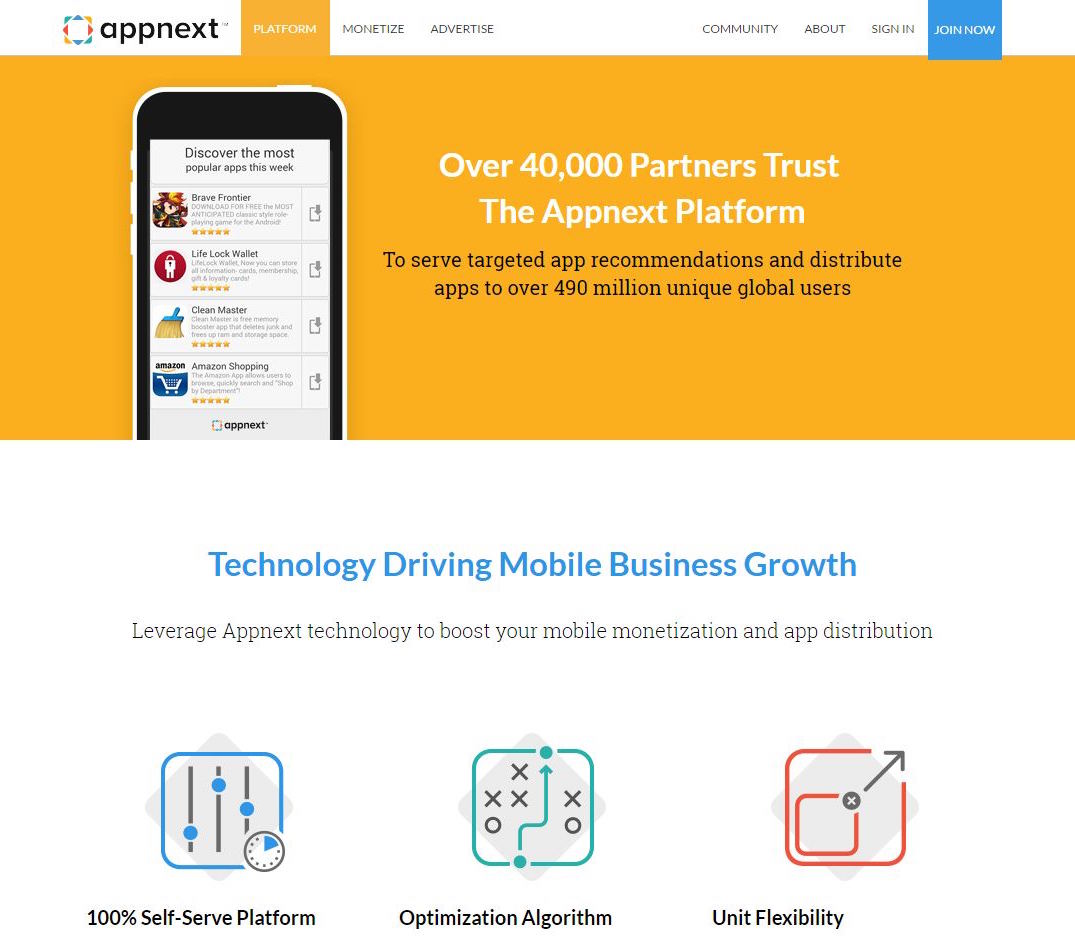
The split-second first impression is positive, as the viewer recognizes that others trust the company. For landing pages especially, the first impression is key — you have milliseconds to emotionally connect with viewers — or not. In this sense, it’s best to use a dedicated landing page software with customizable templates and intuitive design. As marketing automation software like Optimove (to be discussed below) build emotionally intelligent connections with customers. Landing page customization software can also create emotional connections that work.
Technology and emotional marketing
Today’s technology smartly uses data and automation to create an emotionally intelligent connection with customers. The martech and ad tech industry have utilized AI and machine learning to mimic connections.
Certain software solutions, such as Optimove, emphasize an emotionally intelligent connection with company's’ current customer base. Their marketing automation software focuses on retention and re-engagement, offering highly personalized content. The company practices the use of emotional connection (through data and automation) to appeal to existing customers’ tastes and preferences. They use segmentation, past user behavior, and other data points as part of a smart algorithm to send personalized deals.
Autopilot is another marketing automation platform, that specializes in a rich, multi-channel customer journey. Because of their use of segmentation and personalization. The interaction with customers builds an emotionally intelligent relationship with the respective company; the multi-channel approach, while integrating with many other providers helps companies connect and convert more.
Love at first click, then what?
“The best marketing doesn’t feel like marketing,” said the famous “Marketoonist” Tom Fishburne. Does it feel like marketing when you watch a poignant advertisement and connect emotionally with the subject? Does it feel like marketing when you read a genuine positive customer review of kind waitstaff and great service?
Emotional connections happen because we’re human. And we’re built for these connections, wired for them, and rely on them to live a rich, meaningful life. Despite our significant advances in science and technology, human emotion (mainly our subconscious) will always be core to our DNA. Marketing by appealing to raw and genuine human emotion is essential, smart, and pays off.
So, when you design your next landing page, your next CTA or your next ad. Remember the universal themes we’ve discussed to appeal to the human side in all of us. Request an Instapage 14-day free trial today.
About the author
Shayna Smilovitz is a writer living in Tel Aviv, originally from the San Francisco Bay Area. When she's not writing about tech and culture, she loves salsa dancing and busting a yoga move or two. She studied Political Science, Psychology and Social Work. So, she is great at understanding how human connections and emotion intersect with the business world. You can follow her on Twitter.
